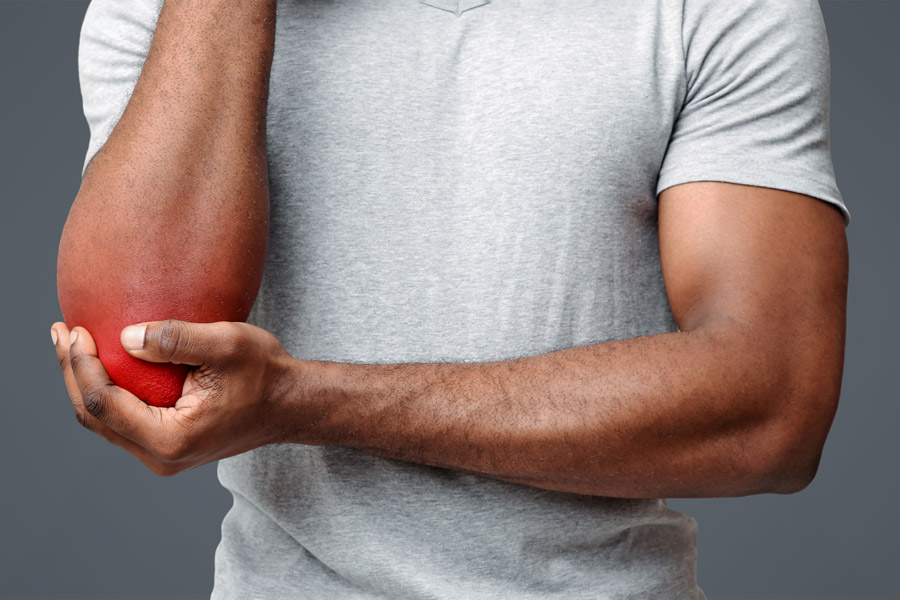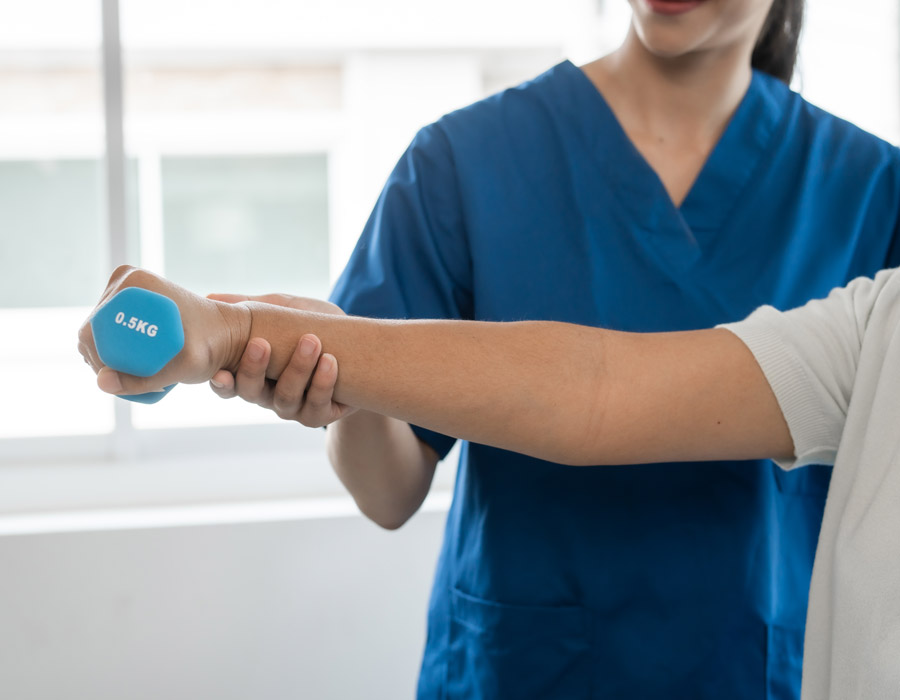Elbow
Elbow pain: causes, diagnosis and modern therapy
Elbow pain can have many causes – from excessive strain in everyday life and sports to rheumatic diseases and acute injuries. Precise diagnosis through clinical examination and imaging techniques (X-rays, MRI) is crucial for determining the appropriate treatment. In addition to conservative measures, arthroscopic and open surgical procedures are available. Below, we present the most common conditions and their treatment options.
Acute elbow injuries
Fast recovery & early mobilization
Minimally invasive surgical techniques for less stress
Targeted aftercare for optimal healing & stability
Elbow dislocations: causes and treatment
Elbow dislocation is the second most common of all dislocations in humans, accounting for 20% of all dislocations. Capsule-ligament tears (100% of all dislocations) are always present, as are cartilage injuries (30–50% of all dislocations), and even fractures of the joint partners (20–30% of all dislocations). Vascular injuries (3–4% of all dislocations) or permanent nerve damage (3% of all dislocations) are less common.
Treatment
After repositioning, the damage is evaluated to determine the therapy:
- Conservative: Simple dislocations with single ligament tears can be treated without surgery.
- Operational: If several primary stabilizing ligaments are destroyed, reconstruction is necessary. The ligament stumps are reattached to their original position to restore stable joint function.
Aftercare
- Physiotherapy begins immediately the day after surgery.
- After the swelling of the arm has subsided, a splint with limited movement is worn for 6 weeks.

Distal biceps tendon rupture: tear of the tendon
A rupture of the biceps tendon near the elbow joint at the radius of the forearm occurs either as a result of an accident or chronic overuse. It leads to significant loss of strength and is easily detectable clinically.
Treatment
- Conservative: Only allows pain-free movement, full strength is not restored.
- Operational: To restore forearm rotation and elbow flexion, the tendon is refixed to the radius using minimally invasive suture anchors.
Aftercare
- Physiotherapy begins on the first day after surgery.
- After the swelling in the arm has subsided, a movement splint is applied for 6 weeks.
Cartilage injuries of the elbow
A cartilage injury to the elbow joint can result from direct impact trauma or shear forces during a dislocation. Combined injuries of cartilage and bone are common.
Treatment
- Conservative: Possible for minor defects.
- Operational: Larger fragments are refixed or treated by microfracture or cartilage-bone transplantation (OATS).
Aftercare
- Physiotherapy begins immediately after surgery.
- Movement splint for 6 weeks for protection.

Plica radialis syndrome: soft tissue injury in the elbow
The plica radialis is a soft tissue tongue between the joint capsule, distal humerus, and radial head. If the plica becomes trapped between the joint bones, it can cause injury, resulting in further pain and swelling. The pain occurs on the outer elbow and can vary depending on the time of day and activity.
Treatment
- Conservative: Immobilization and medication.
- Operational: If symptoms persist, the plica can be removed arthroscopically.
Aftercare
- Usually short rehabilitation period.
- Patients are free of symptoms and able to return to work after approximately 3 weeks.
Chronic diseases and overload syndromes
Effective pain relief & functional improvement
Long-term joint protection through individual therapy
Maintaining mobility & avoiding subsequent damage

Radial/ulnar epicondylitis (tennis and golfer's elbow)
The terms golfer's elbow and tennis elbow refer to pain in the inner or outer joint of the elbow. The causes lie in overuse of the flexor muscles (golfer's elbow) or extensor muscles (tennis elbow) of the forearm. The overuse can be due to one-sided activity or ligament instability of the elbow joint. With chronic overuse, the pain migrates from the muscles to the insertion points on the elbow, where it can lead to structural changes. The medical history and clinical examination are complemented by sonography and magnetic resonance imaging.
Treatment
- Conservative: Medication, physiotherapy, immobilization.
- Operational: If conservative measures do not help, an arthroscopic examination can be performed.
- In chronic epicondylitis, Nirschl operation for reconstruction and stabilization.
Aftercare
- Physiotherapy begins immediately after surgery.
- Movement splint for 6 weeks.
Elbow instability (radial/ulnar)
Capsular ligament instability of the elbow joint is caused by capsular ligament damage and can be treated conservatively.
Treatment
- Conservative: Physiotherapy for stabilization.
- OperationalIf instability persists, a diagnostic arthroscopy is performed. If necessary, ligament reconstruction is performed.
Aftercare
- Physiotherapy from day one.
- Movement splint for 6 weeks.

Loose joint bodies (GK) in the elbow
Loose joint bodies develop as a result of accidents or degenerative diseases such as osteochondritis dissecans. They can lead to joint blockages and pain. Loose joint bodies can cause joint friction, joint blockages, and pain.
diagnosis
In addition to the clinical examination, X-rays, CT or MRI are used.
Treatments
Operational: Almost always arthroscopic removal of the joint bodies.
Aftercare
Physiotherapy begins immediately after surgery.
Joint stiffness and restricted movement (arthrofibrosis)
Elbow joint stiffness is usually caused by post-traumatic or arthritic conditions. The impairment in daily life caused by restricted movement depends on the patient's needs. Even a 20° flexion restriction can severely disrupt daily activities.
Treatments
- Conservative: Physiotherapy and special orthoses for mobilization.
- Operational: If sufficient mobility is not achieved, arthroscopic or open procedures can be performed to remove adhesions or bony superstructures.
Aftercare
Intensive physiotherapy for at least 6 weeks to ensure the surgical outcome.

Osteoarthritis of the elbow joint
Elbow osteoarthritis leads to pain during movement, pain at rest and increasing restriction of movement.
Treatments
- Conservative: Elbow osteoarthritis can be treated conservatively to a certain extent. Depending on the location, there are a number of joint-preserving procedures available to eliminate the osteoarthritis or slow its progression.
- Operational: Endoprosthetics (implantation of artificial joints) is the final step in a series of conservative and surgical joint-preserving procedures. This can involve either covering only part of the joint with an artificial surface or replacing the entire joint. The goal in all cases is to restore pain-free and good elbow function.
Aftercare
- Physiotherapy from the first day after surgery.
- After the swelling has subsided, you will wear a splint for 6 weeks to protect the arm.
Make an appointment now!
Are you suffering from elbow pain or an injury? Our specialists at Munich Sports Orthopedics offer state-of-the-art diagnostics and customized treatments.
Get advice!
Make an appointment now for a personal examination and treatment:
+49-(0)89 4140-7840
sportortho@mri.tum.de
House 524
Ismaninger Str. 22
81675 Munich

